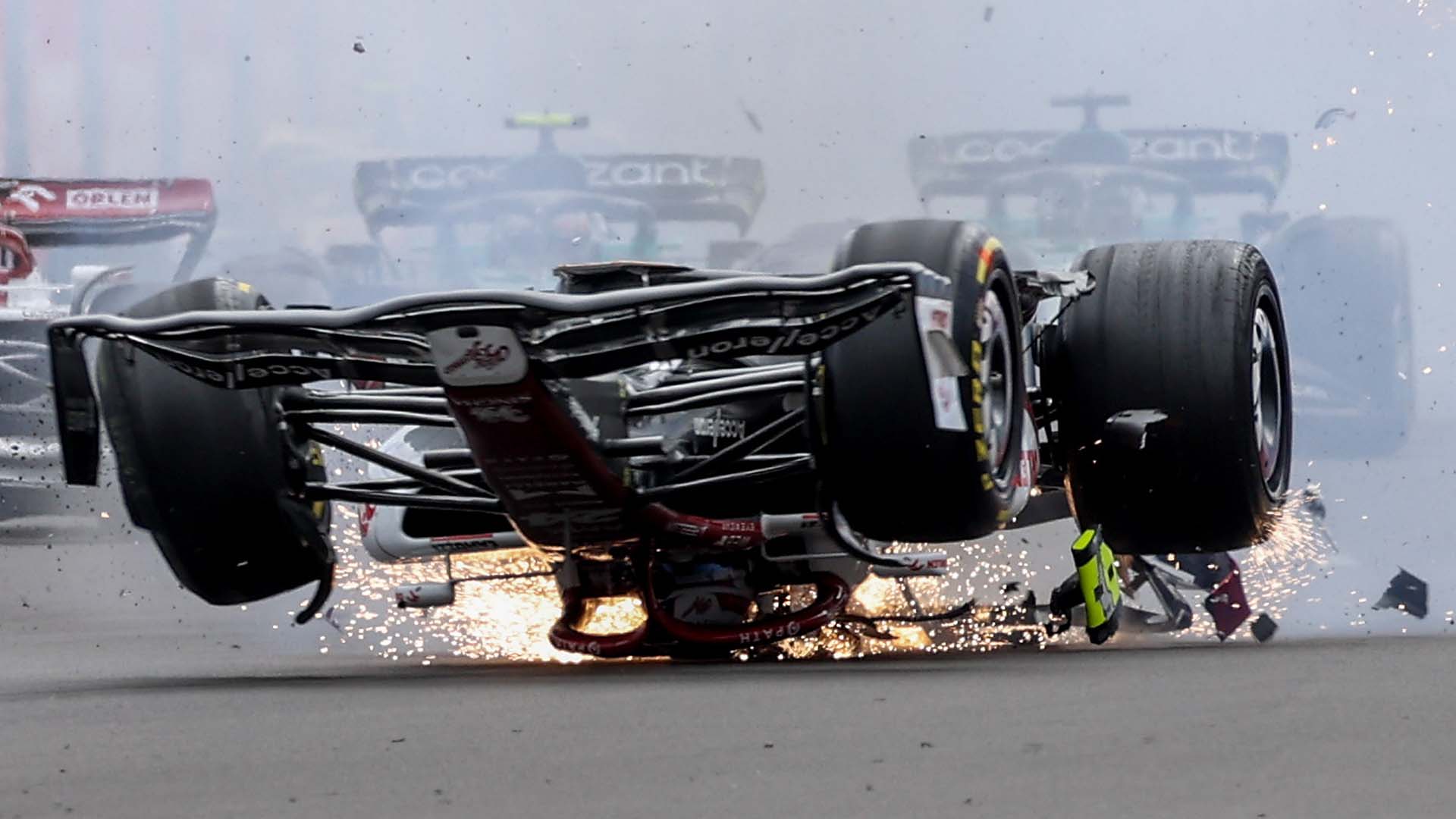

After being involved in a massive rollover crash that sent his Alfa Romeo Formula 1 car rocketing into a catch-fence, driver Zhou Guanyu was cleared by F1’s medics and said to have suffered no major injuries during Sunday’s race at Silverstone. Without a doubt, the car’s halo saved his life. The roll hoop’s failure, however, meant the halo was the only component left to protect the Chinese driver as his car skidded across the tarmac upside down. Why that happened is still unclear, but here’s a breakdown of what transpired on lap one of the British Grand Prix.
Per the rulebook, F1 cars have many extremely specific safety measures built in, though these aren’t spec parts designed by the series for every team to use. Yes, there are lots of spec parts in the 2022 cars but nothing as structural as a roll hoop. Regardless of who builds these components, they all have to be constructed and tested to the same exact standards in order for the FIA to approve them.
The upper part of an F1 car is made up of two roll structures: the primary structure is the roll hoop while the halo is the secondary. The hoop is located just behind the cockpit and is there to make sure the driver is not crushed in the event of a rollover. It must undergo heavy load testing to make sure that it can bear the weight of the car (even if it hits the ground really hard).


As a structural component, the hoop is bonded onto the chassis and the whole assembly is tested to withstand 11 tons vertically, 7.7 tons longitudinally, and 6.6 tons laterally. With F1 cars weighing less than a ton, that means a vertical impact would need to be pretty hard to break the hoop—even after factoring in the 242.5 pounds of fuel cars are mandated to have onboard at the start of the race.
The photos of Zhou’s car grinding across the tarmac, before it reaches the gravel on the outside of Abbey corner, clearly show the roll hoop structure collapsing. Or rather, detaching. Visually, at least, it seems less like the roll hoop itself failed and more like a chassis failure. First, the T-bar goes, and then what looks like the actual hoop of the roll hoop flies away from the car as it begins its rest on the halo alone.
The images are terrifying, being able to see Zhou’s head backlit by the sparks and protected only by the halo. In some crashes, drivers can try to tuck themselves as far down into the cockpit as possible before impact, but that’s not exactly possible when hanging upside-down from your safety belts. In fact, the force the upside-down car applied onto the tarmac was so violent that it literally carved a path on Silverstone’s surface, as photographed by F1 journalist and presenter Craig Slater.
According to the FIA, the halo can withstand 13.2 tons of pressure—so it is tougher than the vertical limit of the roll hoop structure, even though it’s considered secondary protection. At Monza last year, the halo effectively protected Lewis Hamilton from serious injury, if not worse, when Max Verstappen’s rear tire essentially landed on Hamilton’s head.
At the point when the car reached the gravel trap, it dug in, sending it flying uncontrollably toward the tire barrier. Once it hit the tire barrier, it ricocheted with force against the catch fence, which did its job and kept it from going directly into the spectator area.

The catch fence is designed exactly for this, to flex and catch a car or debris in its mesh, but it’s alarming to see one pass over the tires and get wedged between the two. In the end, that was what complicated extracting Zhou, rather than any medical issues—a real testament to how well the safety systems worked on Sunday.
Ultimately, chassis and other components do fail (scarily so, given the two-ton difference in what they can withstand), and the initial hit might have been enough to break the structure, even if there was no malfunction of the roll hoop itself. This we will only know for sure when the FIA releases the full speed and impact figures, among other details.
For now, it’s as race winner Carlos Sainz put it in the press conference after the race: “I feel so happy to be racing in Formula 1 in an era when we are pushing each other at higher than 300 kph like you saw today, racing. You guys cannot imagine the speeds we’re doing in the high speed [corners] and changing directions, fighting for position, and knowing that you can do that safely, or within a safety window.”
In just five short seasons, the halo has become synonymous with safety under the most extreme conditions. Now, it’s the FIA’s turn to reveal exactly what happened, and how the F1 can learn from it.


Got a story tip? Mail it in on tips@thedrive.com